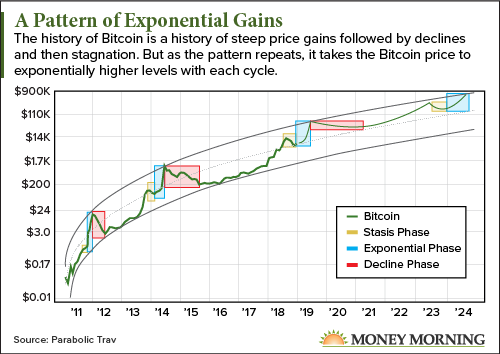Has Bitcoin Gone Mainstream? Four Signs Prices Could Continue To Climb
The bitcoin price recently climbed over the $8,000 mark for the first time since May 2018, according to CoinMarketCap. Many investors are now wondering if the tide has officially turned and the bull market is here to stay. Billionaire investor Marc Lasry told CNBC that the price of bitcoin could reach up to $40,000 as it becomes more accepted and easier to trade.
I believe that as regulatory uncertainty in the space continues to be resolved, mainstream adoption continues to increase, and the CBOE application for a bitcoin Exchange Traded Fund (ETF) is passed — which it very likely soon will be, in my opinion — that the price may well surpass $40,000 by the end of 2018 and could continue to climb as we enter 2019.
Make no mistake about it: as the co-founder of a bitcoin IRA company who has held bitcoin investments previously, I've noticed that 2018 has marked a year of major growing pains for the crypto sector. But with growing pains also comes great growth. As Lasry has purportedly said, I believe we will see bitcoin prices continue to climb. Let’s look at four reasons why.
1. Bitcoin ETFs will expand the pool of cryptocurrency investors.
In June 2018, as previously mentioned, the Chicago Board Options Exchange (CBOE) was reported by NASDAQ to have filed an application with the Securities and Exchange Commission (SEC) to open the world’s first bitcoin ETF. If the application is accepted, then I believe bitcoin will become far more accessible to a wider range of investors who wish to invest in a crypto fund rather than directly into crypto itself.
I am optimistic that the application will be accepted. SEC Director of Corporate Finance William Hinman already stated earlier this year that bitcoin and ether did not necessarily qualify as securities and, therefore, I believe it's likely they won't be subjected to the same stringent regulations as other securities. Furthermore, the SEC also recently proposed easing its rules for low-risk ETFs, ultimately enabling an ETF to enter the market through a quicker and easier process.
Launching a bitcoin ETF (which seems to have been received with overwhelmingly positive feedback) would, to me, be a crucial advancement in the cryptocurrency sector, as it will make digital currencies more accessible to a wide range of people who might currently deem them too volatile or high-risk. As it stands now, investors holding bitcoin need a wallet to trade and store their digital currency. In a recent article, I explained the many nuances to look out for when choosing a cryptocurrency wallet. For a newcomer entering the space, this can be daunting. ETFs will likely appeal to a wider group of investors in that they are traded frequently and, in my experience, highly accessible via investors’ brokerage accounts. Furthermore, many potential investors also have concerns surrounding insurance plans and crypto custodianship or lack thereof.
However, CBOE’s application addresses many of these concerns. For example, the proposal states that the funds will be stored in a cold storage solution, meaning they would be kept offline and therefore inaccessible to potential hackers.
Additionally, an SEC report states that the CBOE's proposal includes an insurance policy for instances when theft or cyber attacks occur, which I believe will give customers peace of mind that their funds will be covered in the event that any wrongdoing takes place — a common concern about cryptocurrencies which may have kept many potential investors away. With these provisions in place, I believe prices will only continue to climb and cryptocurrency will become an even larger component of daily conversation.
2. Mastercard’s new patent represents a trend in consumer thinking.
According to CNBC, Mastercard got a new patent in July 2018 for a strategy it says will improve the speed of cryptocurrency-related transactions. Many sources put the current processing time for a blockchain-based transaction at around 10 minutes; however, the new Mastercard strategy could speed up this process with accounts that can make cryptocurrency transactions directly. Mastercard plans to reduce these transaction times by offering a new type of user account that transacts in cryptocurrencies. If the patented offering is brought to market, it could eliminate the middleman by allowing customers to instantly pay for items on their credit card using digital currency.
Current trends suggest that there is consumer interest in blockchain technology, and I believe patents like Mastercard's are an important response to meet that shift in consumers’ priorities. The patent, along with organizations working to offer faster blockchain-based transactions, reveal the ongoing commitment in the crypto community to make bitcoin transactions faster, more scalable and more streamlined than ever before.


